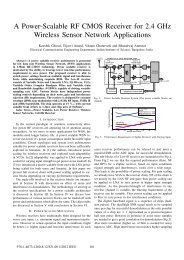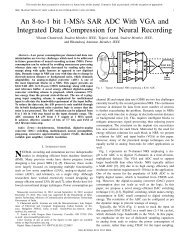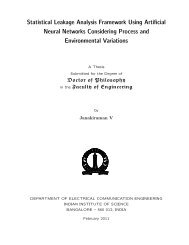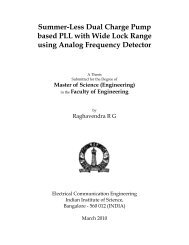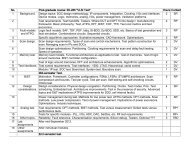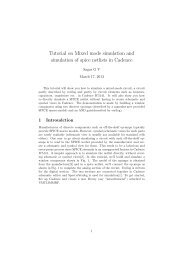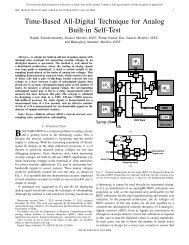NoC design and optimization for Multi-core media processors
NoC design and optimization for Multi-core media processors
NoC design and optimization for Multi-core media processors
You also want an ePaper? Increase the reach of your titles
YUMPU automatically turns print PDFs into web optimized ePapers that Google loves.
CHAPTER 3. LINK MICROARCHITECTURE EXPLORATION 31presents results on power-per<strong>for</strong>mance trade-off studies on Mesh, Torus, Folded Torus,Tree based network <strong>and</strong> a Reduced 2D Torus topologies by varying pipelining in links <strong>and</strong>frequency <strong>and</strong> voltage scaling.The framework is used to study <strong>NoC</strong> <strong>design</strong>s of a CMP using different classes ofparallel computing benchmarks[6]. Traffic patterns from dense <strong>and</strong> sparse linear algebraapplicationsareusedinthisstudy. ThetrafficconsistsofbothRequest-Responsemessages(mimicking cache accesses) <strong>and</strong> One-Way messages. One of the key findings is that theaverage latency of a link can be reduced by increasing pipeline depth to a certain extent,as it enables link operation at higher link frequencies. There exists an optimum degree ofpipelining which minimizes the energy-delay product of the link.Using frequency scaling experiments we show that switching to a higher degree of linkpipelining to achieve higher frequency instead of adding larger buffers is advantageousfromapowerperspective. Twocasestudiescomparingtopologiesbasedonthroughputarepresented. A SystemC based simulation framework containing parameterizable routers,links, traffic generators <strong>and</strong> Sink nodes is used <strong>for</strong> <strong>NoC</strong> exploration.Organization of the ChapterRest of the chapter is organized as follows. A few router modelling, <strong>design</strong> space exploration<strong>and</strong>powerestimationrelatedworkshavebeenintroducedinSection3.1.Adetailedliterature survey router modelling <strong>and</strong> <strong>design</strong> space exploration of <strong>NoC</strong>s had been presentedin Section 2.2 of Chapter 2. <strong>NoC</strong> exploration framework used in the trade-offstudies is described in Section 3.2. Latency, power, per<strong>for</strong>mance trade-offs, frequencyscaling <strong>and</strong> voltage scaling results <strong>for</strong> two case studies are presented in Sections 3.3 <strong>and</strong>Section 3.4. Section 3.3 presents <strong>design</strong> exploration results <strong>for</strong> 4×4 2 dimensional Mesh,a similar Torus <strong>and</strong> an equivalent Folded Torus <strong>NoC</strong>. Section 3.4 presents <strong>design</strong> explorationresults <strong>for</strong> a 16 node (4×4), Torus, Reduced Torus <strong>and</strong> a Tree based <strong>NoC</strong>. Results<strong>and</strong> findings are summarized in Section 3.5.




